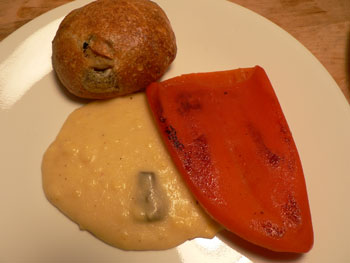 Polenta and Wüsthof
Polenta and Wüsthof
After my week of cooking big meat, I’ve been feeling less than inspired to make anything involving serious preparation. This has been a week of pierogies and quiches and laziness, but for the record we’ve had no take out. I have to be desperate to order in or pick up. I’d have to decide that $20 is better spent on clammy Chinese food than on something quick and easy from Whole Foods, which is never the case. We were going to watch Lost at Lyons’s tonight, so I had to cook something that could be finished and consumed before 8:30. I asked Sabena for an idea, and she quickly said, “polenta.”
Polenta is the easiest thing in the world to make.

I didn’t want to make just any polenta, so I found a recipe in The Gourmet Cookbook for baked polenta with Parmesan cheese. I had all of the ingredients on hand, but I foolishly skimmed over the recipe and ignored the fact that I was to refrigerate soft polenta for an hour before baking it. I didn’t have time for that, so I just made one cup of polenta in three cups of water and one cup of milk. I added four tablespoons of butter, one teaspoon of salt, a couple of dried cèpes, a heavy dose of freshly ground pepper, and as much Parmesan as I could stand to grate. I had no meat in the fridge, so I seared some jarred roasted red peppers. Teamed with a delicious olive roll from the bread kitchen at work, this made a lovely and cheap, albeit early 90s, meal.
Unfortunately, this meal provided no occasion to use my sweet new paring knife.

I tried four or five different Wüsthof knives at Sur La Table, and the knifemonger and I decided on this Le Cordon Bleu model because of its narrow, Japanese-style blade bottom. I looked at Alton Brown’s paring knife, which has a cool angle to it that helps prevent knuckle rapping. But I don’t think I could stand to see his face on the blade for all eternity, and I don’t think it’s worth its high price. Henckels has paring knives priced in my range, but Cook’s Illustrated doesn’t recommend them, and the knife guy said the steel isn’t as strong as in Wüsthof.
As soon as I have something to pare, I’ll either rant or rave. Sometimes I think I should just buy the cheapest knife I can find. I heard a master chef at work say he doesn’t care what kind of knife he uses as long as it’s sharp. And I heard a story about an award-winning Japanese chef who used a big, cheap chef’s knife for everything from filleting tuna to carving roses out of truffles.

Comments
It’s hard to tell from your photo how long the knife is. I like my paring knives on the stubby side; it gives me more control. And I’ve gotten used to that semi-birdbeak shape, almost like the paring knife version of the santoku knife. They’re hard to sharpen, though.
Add a comment